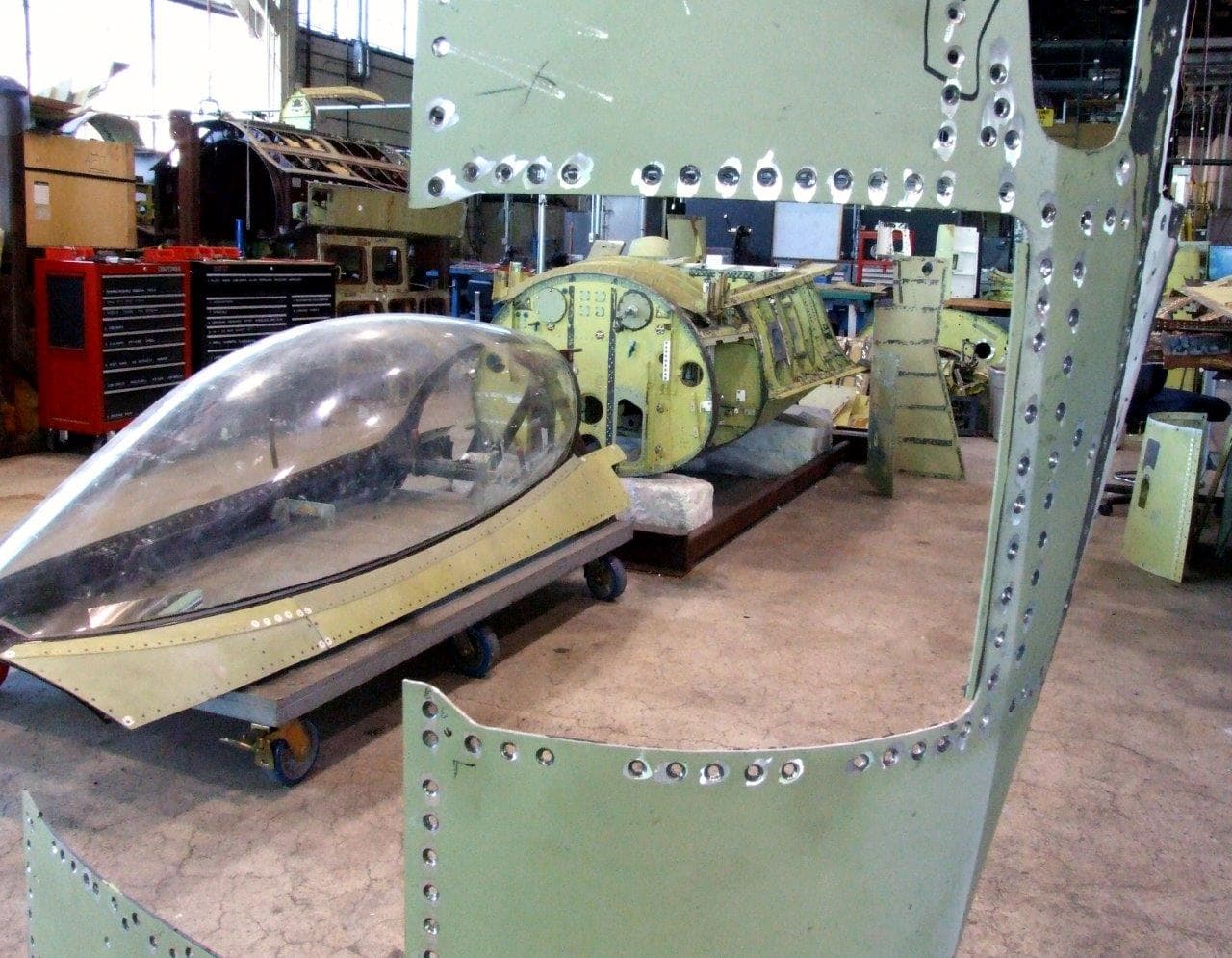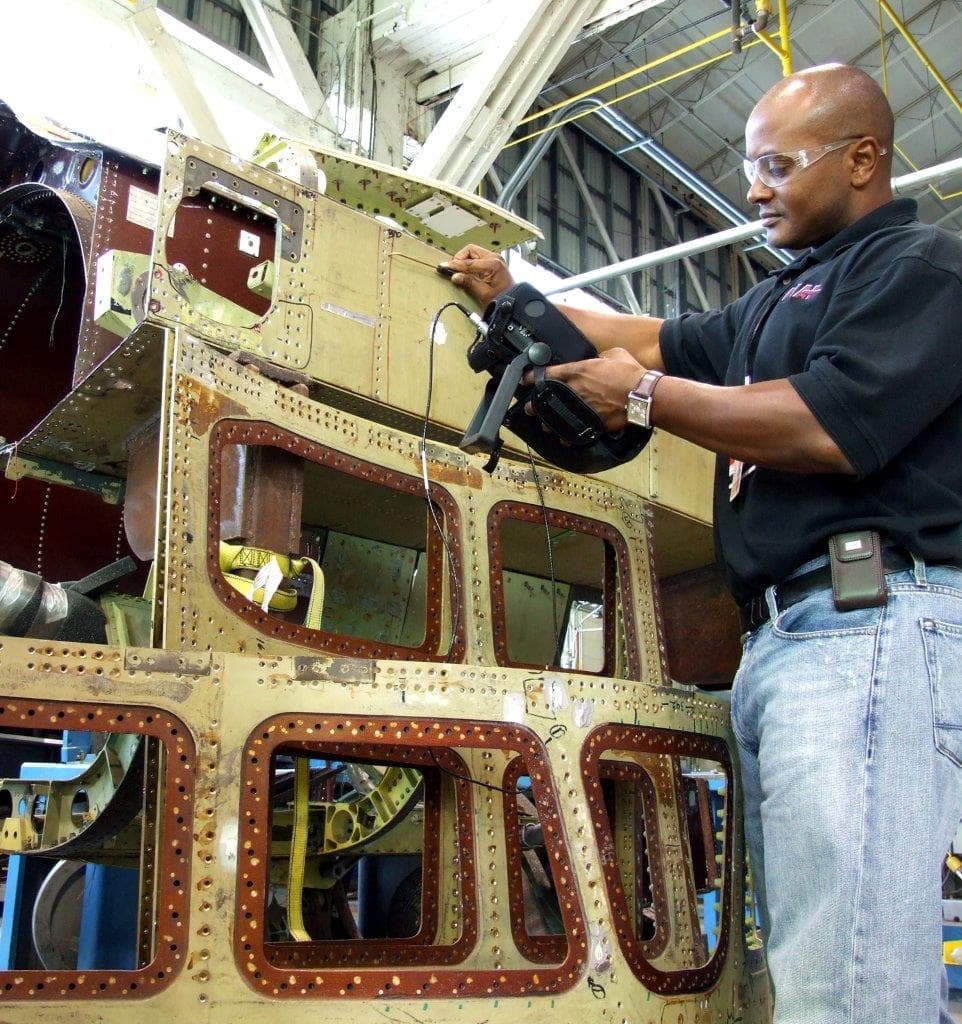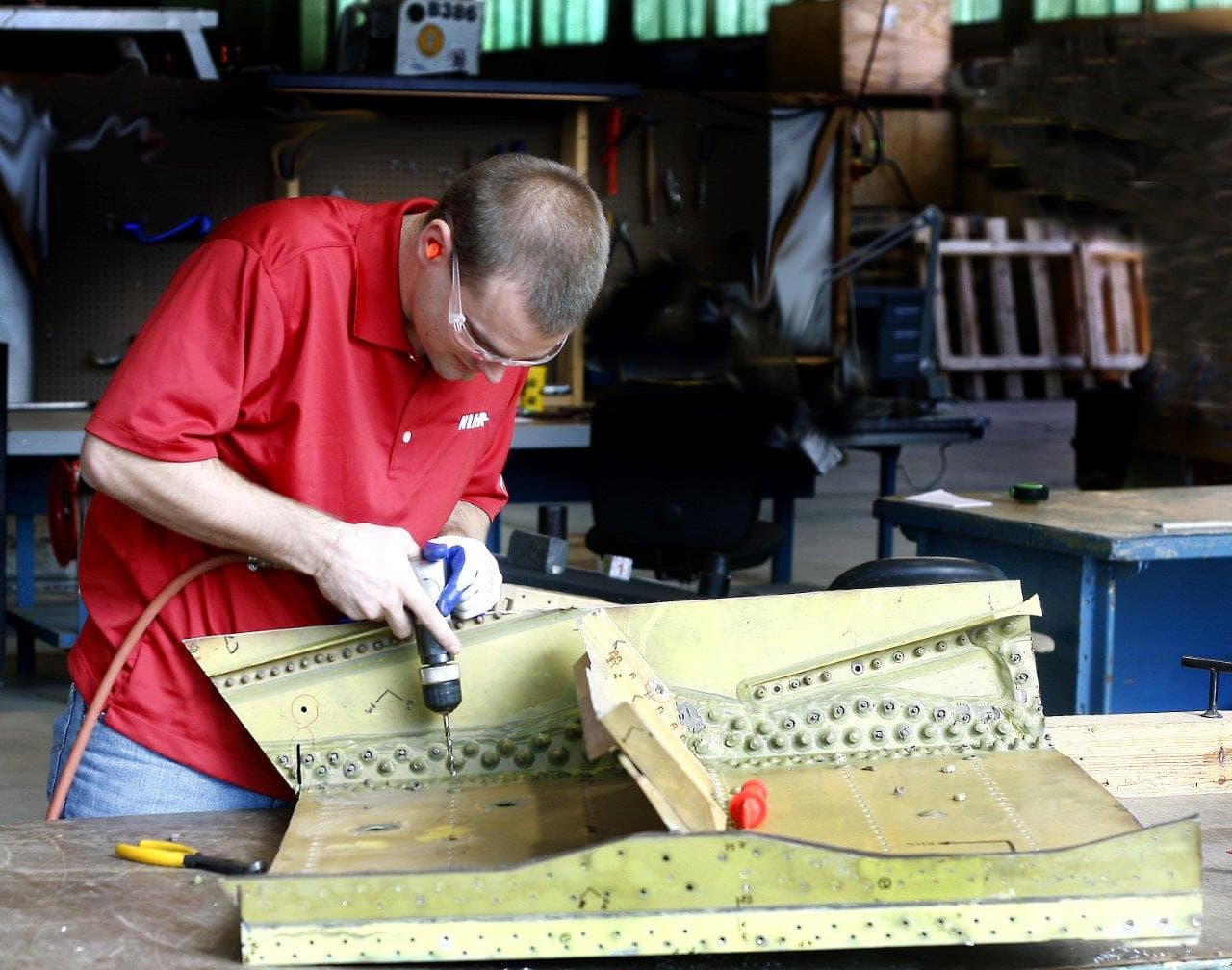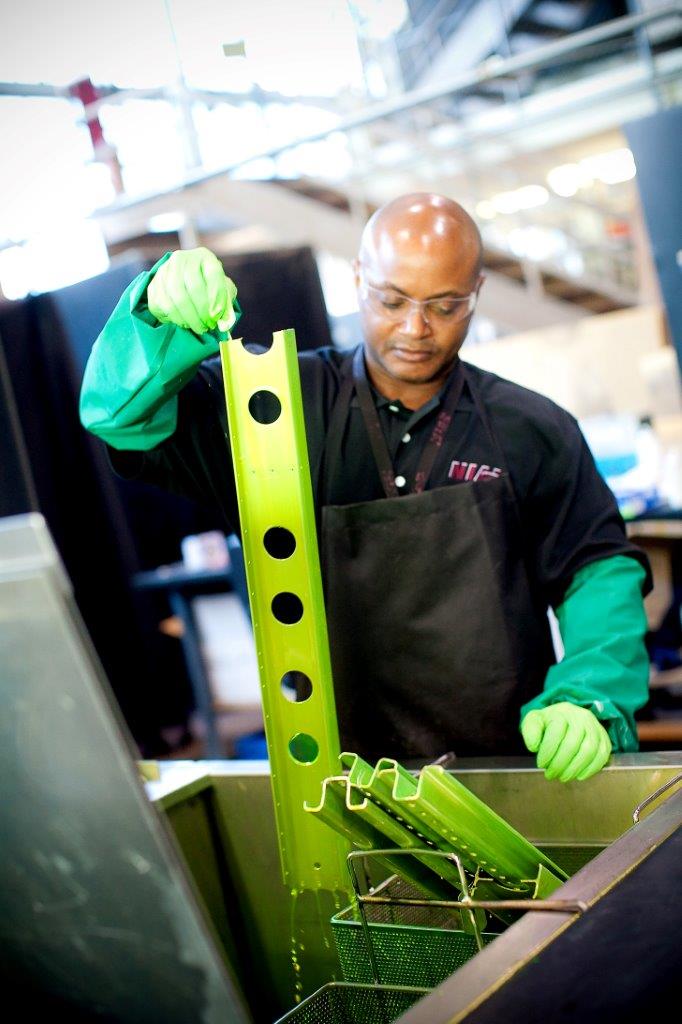Peeking Under The Skin Of Aging Aircraft
16:19 minutes

An aircraft begins to age the moment it leaves the assembly line. Every takeoff, landing, or minute of turbulence in flight adds extra stresses to an airframe. Some problems of aging are easily visible and corrected by routine maintenance—but others can remain hidden away.
[When bird meets airplane, bird always loses.]
Melinda Laubach-Hock, director of the Aging Aircraft lab at the National Institute for Aviation Research at Wichita State University, describes how her lab first strips away the paint from a sample plane and then disassembles it piece by piece, looking for signs of cracks, corrosion, and metal fatigue. The lab has looked at everything from a Cessna that made regular tourist flights over the Grand Canyon, to a massive KC-135 military refueling craft, and everything in between.



Melinda Laubach-Hock is director of the Aging Aircraft Lab at the National Institute for Aviation Research of Wichita State University in Wichita, Kansas.
IRA FLATOW: This is Science Friday. I’m Ira Flatow. Not too long ago, as I settled down in my seat on a long flight to Europe, I observed how the flight attendant was preparing for the upcoming in-flight movie. He didn’t go to a flat panel screen and key in the digital film. No, he pulled a VCR out of a pile, slipped it into the slot of the VCR player, and waited for the squiggly lines to disappear from that single, small TV set we all had to share. It was then that it struck me, just how old is this plane?
Sure passenger aircraft in the US have strict rules on the total number of flight hours the airframe can have, plus limits on takeoffs and landings. And planes do undergo careful inspections and maintenance. But how do they know exactly what might need inspecting or maintaining? Joining me now is Melinda Laubach-Hock. She is Director of the Aging Aircraft Lab at Wichita State University’s National Institute for Aviation Research, NIAR. That’s here in Wichita, Kansas. And she’s here at KMUW, our studios. Welcome to Science Friday.
MELINDA LAUBACH-HOCK: Thank you for having me.
IRA FLATOW: What do you mean when you say an aging aircraft? How old are aircraft out there that we’re flying on?
MELINDA LAUBACH-HOCK: Well, the term “aging aircraft” is really a misnomer. A lot of people think that aging aircraft only relates to aircraft design in the ’50s, ’60s, ’70s. But really, we start the aging process the minute an aircraft rolls off the production line. We want to get ahead of the problems before they happen.
IRA FLATOW: So what are some of the main problems that you look for, that you want to get ahead of?
MELINDA LAUBACH-HOCK: Most of the aircraft have cracking at some point in their life also corrosion issues. So it’s best to have a plan from the beginning on how you’re going to treat those before they come up in the fleet.
IRA FLATOW: Which is? The plan– what’s the plan?
MELINDA LAUBACH-HOCK: The plan really depends on the aircraft. Engineers have gotten very good at predicting when cracks will occur, where they will occur. And they develop really good inspection plans to address those and keep our aircraft safe. But every now and then, there’s an issue that just pops up at a certain point in the service life that no one could predict, because we’re not perfect at doing engineering work. And so that’s why the work we do with the Aging Aircraft Lab is very important.
IRA FLATOW: What do you study there?
MELINDA LAUBACH-HOCK: Basically we take aircraft completely apart when they’ve reached a certain point in their life. When their life is almost over, we go find an aircraft from the fleet, and we take it apart piece by piece. We do very, very detailed inspections, inspections that would be impossible if you were going to return this aircraft to service. We’re looking for very small cracks, corrosion, things that could become a problem as the aircraft continues to age through its service life.
IRA FLATOW: So you have to destroy the aircraft to really look at it in detail?
MELINDA LAUBACH-HOCK: That’s right. Unfortunately, to do a very precise job, which is what we’re looking to do and find absolutely everything, we have to destroy the aircraft.
IRA FLATOW: So do you have to buy the aircraft? Do they get donated from the aircraft?
MELINDA LAUBACH-HOCK: It really depends on the research program. Most times, the aircraft’s donated to the university, since we’re an educational institution. The aircraft’s donated. Occasionally we’ve been given funds by the FAA to do research. And part of that includes purchasing an airplane. And so we’ve done both.
IRA FLATOW: And so, is there a predictable pattern that an aging aircraft goes through that you can look for?
MELINDA LAUBACH-HOCK: Not really.
IRA FLATOW: No. That’s what makes it harder.
MELINDA LAUBACH-HOCK: That’s what makes it harder. If there was one textbook solution to the problem, we wouldn’t be doing the research we’re doing. It really depends on how the aircraft’s designed. Aircraft are designed for very different reasons. We don’t look at just passenger jets. We look at military aircraft as well. So in our lab, we’ve looked at bombers, tankers, cargo aircraft, fighter aircraft. We do a lot of DoD support at our facility.
IRA FLATOW: What does the term “metal fatigue” mean?
MELINDA LAUBACH-HOCK: Basically metal fatigue, back when aircraft were first designed, we were worried about static strength. The one time load applied to the aircraft– what’s the maximum it can sustain? Then in the ’50s, we started seeing incidents of airplanes cracking at much lower loads. And we weren’t quite sure why that was happening. And it ended up being metal fatigue.
And metal fatigue is when you apply load over and over and over to the airframe, it becomes weaker as a function of time. And small cracks begin to appear and as long as you address those with an inspection program, you don’t have a problem. But it’s definitely something we have to keep a look out for.
IRA FLATOW: And in fact, probably the most famous case of that was the first case of the de Havilland Comet in 1954.
MELINDA LAUBACH-HOCK: That’s correct, either that one or the Aloha incident in 1988 as well really sparked the start of fatigue research on air frames.
IRA FLATOW: I know you probably don’t remember this movie called No Highway in the Sky, but it was a Jimmy Stewart movie, and I’m going to read from IMDb of it. It says, “Fatigue after a certain number of flight cycles as outlined in the 1948 novel and the 1951 film came true with the failure of that comet in 1954.” So people were thinking about this way back, right?
MELINDA LAUBACH-HOCK: Right. People were thinking about it, but we didn’t necessarily have the experience or the engineering technology to be able to address it at that point in time. Of course, things have gotten way better in this generation.
IRA FLATOW: Are planes today stronger than the older planes?
MELINDA LAUBACH-HOCK: Actually, I would say stronger is, again, kind of a misnomer. Whether you’re talking stag strength, whether you’re talking fatigue strength, what we’ve gotten better at is being able to analyze the designs. The older aircraft might be a little bit stronger, because if we didn’t know, we just made the part a little bit thicker.
IRA FLATOW: You overbuilt.
MELINDA LAUBACH-HOCK: Right. Just built it thicker and a little bit heavier.
IRA FLATOW: Yeah. We don’t know, so we just build it in extra tough.
MELINDA LAUBACH-HOCK: Right. But now that we’ve become more worried about fuel economy and some of the economic issues surrounding aircraft, we’re trying to design them lighter and more efficient. When we do that, we’re also approaching the edge of design.
IRA FLATOW: Let’s go to the phones. Our number– 844-724-8255. Let’s go to Don in Prescott Valley, Arizona. Hi, Don.
DON: Hello.
IRA FLATOW: Hi there, go ahead.
DON: What an interesting program.
IRA FLATOW: Thank you.
DON: No Highway in the Sky is one of my favorite movies. I’m an aging former aerospace engineer myself from the 1960s. I worked at Ryan Aeronautical mainly in electronics on Surveyor, Apollo, and Viking. And my comment is that I took my whole family, including my in-laws, to Hawaii. And as I was getting on the plane, to hop from one island to another, I noticed a lot of cracks around the door. And I told the stewardess to please tell the pilot. And I don’t know if she ever did. So I’ve always felt guilty that I didn’t follow up some other way. Because that was just a few months before the top of the plane ripped off. I don’t know if it was the same plane.
My question is, since I found a whole lot of mistakes and problems in various electronics over the years, I wondered if the same level of research is being done on the electrical systems, the ones that can cause fires, explosions, and so forth? That’s my question.
IRA FLATOW: See, you’re a modern-day Jimmy Stewart then, because you know the movie?
DON: Actually, I did write a memo saying I found a diode that was charging a big capacitor, and it was a signal diode not a power diode. And it failed in a thermal vacuum. And when my boss came to me and said, didn’t you notice this? I handed him a copy of my memo.
IRA FLATOW: There you go.
DON: And he just grinned, and looked worried and walked away without saying a word.
IRA FLATOW: Melinda, what do you think of his– thanks for calling.
MELINDA LAUBACH-HOCK: Yes, in parallel, most of what we do is structural airframe research. But there’s also engine research. There’s a great deal of electronics research. Basically anything that goes into an airframe is researched and tested to the extreme level to maintain the safety standards.
IRA FLATOW: So you take a plane and you wiggle it and bend it and all kinds of stuff to see where it’s going to fail?
MELINDA LAUBACH-HOCK: Yes. That is also done. We don’t want to wait till an aircraft is 10, or 20, or 30 years into service. So we can go in and perform structural testing. And what we do is we mechanically apply the loads that the aircraft would see over its lifetime. We simulate takeoffs, and landings, and large gusts, and anything that would cause cracks or damage to the airframe. And we can do an entire lifetime of an airframe in a couple of years instead of waiting for 20, 30 years down the road.
IRA FLATOW: Well, that’s interesting. You talked about doing a lot of military aircraft. We have 50-year-old military, B-52s, planes like that that are still flying.
MELINDA LAUBACH-HOCK: I just finished–
IRA FLATOW: How do you keep them flying?
MELINDA LAUBACH-HOCK: This is an interesting story. I just finished a program on the KC-135. It was designed and built in the ’50s and the ’60s.
IRA FLATOW: That’s a tanker.
MELINDA LAUBACH-HOCK: That’s a tanker. That’s basically your aerial gas station for about everything else we fly. And they originally designed that aircraft to last 10 years. They wanted to get through the Vietnam conflict, and they were going to design a new tanker. Well, now here we are in 2017. They’re looking to fly that aircraft to 2040, 2050, maybe even beyond. So how do you keep an aircraft flying when the average fleet age is going to reach 80 years?
So the tear down process was very important to them. Because when we do structural tear down, we’re able to look places that no one’s looked since the aircraft was originally built.
IRA FLATOW: As such as?
MELINDA LAUBACH-HOCK: Such as inside major structural features like bulkheads, inside the very details of the wing, where we usually see cracks. We do the best inspections we can when the aircraft is in one piece. But if we have the luxury of taking it completely apart, we can see much more than you can through just general inspection.
IRA FLATOW: And so how do you look for these little cracks?
MELINDA LAUBACH-HOCK: We use visual inspection and enhanced nondestructive inspections. There’s techniques out there called fluorescent penetrant, eddy current–
IRA FLATOW: Well, we like to get into the weeds on this stuff. So give us some details of what you mean.
MELINDA LAUBACH-HOCK: Sure, sure. So fluorescent penetrant is basically you dip the part into this oily fluorescent substance. And the substance seeps down into any surface breaking discontinuity like a crack or like corrosion. You wipe it off the surface, and you shine a black light on it. And any of the trap penetrant glows in the dark. And so it definitely leads you to a very specific part on the spot that you could easily miss if you’re looking at thousands of square inches of aircraft metal.
We also use an eddy current machine, and it basically induces an electromagnetic field into the part. And you have trained technicians that look at a scope. And when they get a specific signal, that tells them there’s a crack. We use ultra sound kind of like you do in the medical field when you’re looking at babies. You can do that with composite parts, looking at how the sound reflects back.
IRA FLATOW: But you can’t do this. I don’t know, but I’m going to ask you– how do you do that with an aging old iconic plane like that, B-52 or the KC-130? You can’t take that apart and destroy it, can you?
MELINDA LAUBACH-HOCK: Actually, we did.
IRA FLATOW: You did?
MELINDA LAUBACH-HOCK: We got the four KC-135 we did. We’ve also done B-52 in our facility. We’ve gotten them out of Amark, which is the aircraft boneyard in Arizona–
IRA FLATOW: Been there. Love it.
MELINDA LAUBACH-HOCK: –where they retire these aircraft.
IRA FLATOW: Yeah.
MELINDA LAUBACH-HOCK: Once they’re done with their useful life, they just kind of sit out there. And they’re parted out for spares. And if we can get an aircraft donated to us where we can gain some valuable information to keep the rest of the fleet flying, that’s a very good use of an airframe like that that has minimal use to the Air Force or to any other operator.
IRA FLATOW: I know when we have old cars, and you try to rebuild an old car, take care of it, do you have any problem getting the parts you would need?
MELINDA LAUBACH-HOCK: Well, since we’re not rebuilding them, we don’t have that problem. Basically, we take apart the air frame. But the military does have that problem. And that’s why they keep the boneyard. They go out, and they find an old tanker, take it apart, get the pieces they need to repair the tankers that they’re using now.
IRA FLATOW: I’m Ira Flatow. This is Science Friday from PRI, Public Radio International. We’re talking with Melinda Laubach-Hock who is Director of the Aging Aircraft Lab at the National Institute for Aviation Research at Wichita State University here in Wichita. How did you get involved in this? It sounds fascinating. What’s your experience? You sound like you have a lucky, once-in-a-lifetime kind of a job here.
MELINDA LAUBACH-HOCK: I do, actually. I grew up in Western Kansas. I was a small farm town girl, and I always had this great interest in airplanes. I came to Wichita State on a Wallace Scholarship, which is a big scholarship in the Wichita area. I came here, started working for a local aircraft company, was part of a layoff cycle, found a job at the institute working as a graduate student, and just had a lot of interest in how aircraft are built, how aircraft are maintained, the sustainment side of it more than the design side, and just kind of fell into this position. I’ve been there 15 years now.
IRA FLATOW: Wow, just getting started.
MELINDA LAUBACH-HOCK: Just getting started.
IRA FLATOW: [LAUGHS] Let’s go to James in Annandale, Virginia. Hi, James. Welcome to Science Friday.
JAMES: Thank you, Ira. I appreciate it. My question, really quick, is when you’re dealing with an aircraft like the Boeing 787, you’re dealing with composite structures not just metal structures. How are you going to change the research program to take that change into account?
IRA FLATOW: Interesting.
MELINDA LAUBACH-HOCK: We’ve already begun to do that. Wichita State does significant amount of research in the area of composites, both for manufacturing and testing. We’re just getting into that in the aging aircraft world, because composites haven’t been used widely on older airframes. But it’s just a matter of using a different inspection technique. As I mentioned before, you know, when we’re dealing with composites, ultrasound is a great option instead of eddy current that we typically use on metallic structure. But the idea of taking it apart and looking at the details and maybe even testing the strength after the fact, those are all things that are applicable to composites as well.
IRA FLATOW: Give me an idea how long it takes to take a whole airplane apart.
MELINDA LAUBACH-HOCK: It depends on the size of the aircraft. We’ve done really small Cessna-sized aircraft in the past. That’s about a year long project. The larger planes take about three years in general.
IRA FLATOW: Do you ever take a plane apart and say, why did they design it this way? This is kind of crazy.
MELINDA LAUBACH-HOCK: It’s not always, why did they design it this way? But a lot more of what I’ve seen is, why did they repair it this way?
IRA FLATOW: Oh.
MELINDA LAUBACH-HOCK: When you’re dealing with military aircraft, you have to think they may be over in the desert, in war time. They’ve got to get this aircraft patched back together so it can get back to the United States. So that’s definitely been– the more interesting part for me is, how did someone come up with this design and how did they do this out in the middle of nowhere, really?
IRA FLATOW: Is there a tool that’s not invented yet that you would love to have if you could spend any amount of money inventing it?
MELINDA LAUBACH-HOCK: Of course. Anybody would love–
IRA FLATOW: What would you want?
MELINDA LAUBACH-HOCK: Anybody would love a magic box that you could just plug into an airplane, and press a button, and it tell you where all the defects are, kind of like your car is now. You get a code–
IRA FLATOW: But is it possible? Is it possible for a plane to diagnose its own problems? Could you design it that way?
MELINDA LAUBACH-HOCK: Absolutely. We’ve actually done some research on what’s called structural health monitoring, which means embedding sensors into certain parts of the airframe as you build it and then monitoring certain properties of the airframe as you go on. And when you start to see a change in property, that drives your maintenance to that location. So we’re already kind of heading there.
IRA FLATOW: But you know, we know there are red lights that light up in the airplane when something is going wrong. Could the sensors do that and tell you way in advance that some parts are beginning to fail?
MELINDA LAUBACH-HOCK: I think we’ll get there. We’re just not there yet.
IRA FLATOW: Yes, some sort of system that is– you know, you see stuff on Star Trek or whatever that they’ve done this already. But the way we’re moving so fast with technology, we think we should be able to do that.
MELINDA LAUBACH-HOCK: Right, and they are able to do that. I mean, they do it with engines. Just think about the engine in your car. It gives you a light and says something’s wrong with it. That’s applicable to airframes too. We just haven’t been able to get there with the structural part of an airframe yet.
IRA FLATOW: Well, we’re glad you came and told us about what you’re doing and what your research is like out there.
MELINDA LAUBACH-HOCK: Well, thank you very much for inviting me.
IRA FLATOW: You’re welcome. Melinda Laubach-Hock, she is the director of the Aging Aircraft Lab at Wichita State University’s National Institute for Aviation Research. Right here in Wichita.
Copyright © 2017 Science Friday Initiative. All rights reserved. Science Friday transcripts are produced on a tight deadline by 3Play Media. Fidelity to the original aired/published audio or video file might vary, and text might be updated or amended in the future. For the authoritative record of Science Friday’s programming, please visit the original aired/published recording. For terms of use and more information, visit our policies pages at http://www.sciencefriday.com/about/policies/
As Science Friday’s director and senior producer, Charles Bergquist channels the chaos of a live production studio into something sounding like a radio program. Favorite topics include planetary sciences, chemistry, materials, and shiny things with blinking lights.